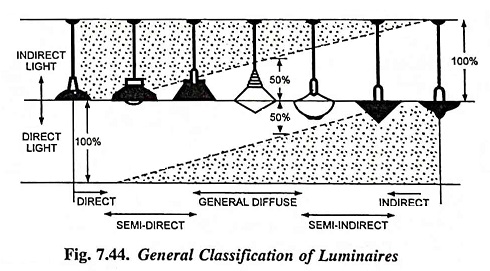Types of Lighting Schemes:
The distribution of the light emitted by lamps is usually controlled to some extent by means of reflectors and translucent diffusing screens, or even lenses. The interior types of lighting schemes may be classified as
- Direct lighting
- Semi-direct lighting
- Semi-indirect lighting
- Indirect lighting and
- General lighting.
1. Direct Lighting:
It is the most commonly used type of lighting scheme. In this lighting scheme more than 90 per cent of total light flux is made to fall directly on the working plane with the help of deep reflectors. Though it is most efficient but causes hard shadows and glare. It is mainly used for industrial and general outdoor lighting.
2. Semi-Direct Lighting:
In this lighting scheme 60 to 90 per cent of the total light flux is made to fall downwards directly with the help of semi-direct reflectors, remaining light is used to illuminate the ceiling and walls. Such a lighting scheme is best suited to rooms with high ceilings where a high level of uniformly distributed illumination is desirable. Glare in such units is avoided by employing diffusing globes which not only improve the brightness towards the eye level but also improve the efficiency of the system with reference to the working plane.
3. Semi-Indirect Lighting:
In this lighting scheme 60 to 90 per cent of total light flux is thrown upwards to the ceiling for diffuse reflection and the rest reaches the working plane directly except for some absorption by the bowl. This lighting scheme is with soft shadows and glare free. It is mainly used for indoor light decoration purposes.
4. Indirect Lighting:
In this lighting scheme more than 90 per cent of total light flux is thrown upwards to the ceiling for diffuse reflection by using inverted or bowl reflectors. In such a system the ceiling acts as the light source, and the glare is reduced to minimum. The resulting illumination is softer and more diffused, the shadows are less prominent and the appearance of the room is much improved over that which results from direct lighting. It is used for decoration purposes in cinemas, theatres and hotels etc. and in workshops where large machines and other obstructions would cause troublesome shadows if direct lighting is employed.
5. General Lighting:
In this scheme lamps made of diffusing glass are used which give nearly equal illumination in all directions.
